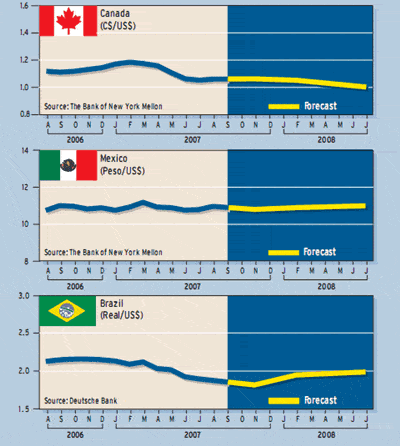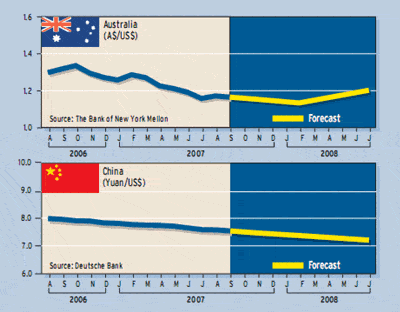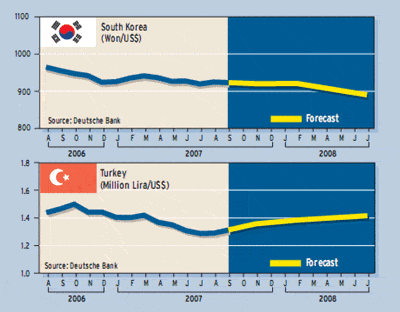Foreign exchange / corporate financing news
“The dollar’s decline must now become a matter of consideration for the US Treasury and the central bank,” says Ashraf Laidi, chief foreign exchange analyst at CMC Markets US, based in New York. “Previously, the yen’s continued weakening had acted as a major stabilizer of the dollar’s overall value at a time when the US currency hit all-time lows against the euro and multi-decade lows against the Aussie [Australian dollar], Canadian dollar, sterling [British pound] and New Zealand dollar,” he says.
Revelations of subprime troubles boosted the yen on falling risk appetite in global markets, making the dollar’s decline increasingly pervasive. On August 6 the dollar index briefly dipped below the 80 reading, a key psychological mark, as market participants said the Federal Reserve was edging increasingly close to easing monetary policy in response to a downturn in the credit cycle that threatened to spread from subprime borrowers to emerging markets.
Unlike the events of late February and early March, when the unwinding of the carry trades manifested itself in a broad yen rally, recent market events are translating into broad dollar declines because of the subprime fallout, which hit the US the hardest, according to Laidi. “Such implications increase the likelihood of an interventionist rate cut from the Fed aimed at shoring up market liquidity,” he says. The carry trade involves borrowing cheap yen or Swiss francs and investing in higher-yielding securities, such as bonds in Australia and New Zealand.
The Australian dollar fell nearly 5% against the greenback in less than a week after reaching an 18-year high of 88.71 US cents on July 25. The collapse was paralleled by similar moves among other high-yield currencies such as the New Zealand dollar and to a lesser extent other commodity currencies such as the Canadian dollar, according to Michael Woolfolk, senior currency strategist at The Bank of New York Mellon.
“As a major beneficiary of the yen carry trade, the Australian dollar has sustained a significant appreciation against the yen as well as the US dollar,” Woolfolk says. “As waves of risk aversion continue to move through global financial markets, players are increasingly concerned over future Australian dollar selling.”
Before the sell-off, the Australian dollar had rallied 30% against the yen and 25% against the US dollar from March 28, 2006. Just before its sell-off, the Australian dollar had rallied for 12 consecutive days from July 6 to July 23. “This was the first time in the post-Bretton Woods era of flexible exchange rates that this has happened,” Woolfolk says. “It was not only unprecedented for the Australian dollar but also unprecedented for a major floating exchange rate in the absence of market intervention,” he says.
The Australian dollar sell-off in late July coincided with two important developments, Woolfolk says. The first was the Japanese parliamentary elections on July 29, when prime minister Shinzo Abe’s Liberal Democratic Party lost ground to the Democratic Party of Japan and the Bank of Japan was expected to begin raising interest rates. The second development was further deterioration in the US subprime mortgage market. These factors led to fear of a full-fledged unwinding of the yen carry trade.
Yen strength is expected to be greatest against those currencies that have gained the most from the carry trade, Woolfolk says. “Using this measure, the Australian and New Zealand dollars have the furthest to fall among the majors, followed by the British pound and the US dollar, with the euro, Canadian dollar and Swiss franc bringing up the rear,” he says.
Recent pullbacks from the carry trade have been very mild compared with the collapse of the trade in 1998, says Gabriel de Kock, director and the currency economist in Citi’s economic and market analysis department in New York. “This shift reflects durable changes, suggesting that the eventual unwinding of the yen carry trade could be significantly smoother than the 1998 experience,” he wrote in a report. “While a small number of large, highly leveraged market participants dominated the 1998 carry trade, market liquidity has increased many times over, and the positions today are much more widely dispersed.”
While policy normalization by the Bank of Japan eventually should lift Japanese government bond yields and undercut the yen carry trade, this scenario may be years, rather than months, away, de Kock says. And while high-yield corporate spreads have jumped and the spreads on low-rated mortgage-backed securities have skyrocketed, emerging market spreads have risen only modestly, suggesting that investors are reducing risk selectively, he says.
US economic growth rebounded to 3.4% during the second quarter from 0.6% in the first three months of this year. “The recent increase in market expectations for Fed rate cuts is largely predicated on the belief that the subprime housing woes will be enough to slow the overall economy in the second half,” says Marc Chandler, global head of currency strategy at Brown Brothers Harriman in New York. “We disagree with this outlook and look for the US economy to reassert its strength in the coming months,” he adds. It likely will take a couple more months of decent US data, however, before markets ultimately change their view on the Fed, he cautions.
European Central Bank president Jean-Claude Trichet used the phrase “strong vigilance” in a statement to the press in early August. “That is as clear a signal as one can get of a September rate hike and comes as some questioned whether the ECB might remain on hold due to the price adjustments in the credit market,” Chandler says.
While cautious, the ECB, like other central banks, does not currently see recent market turmoil as systemic or significant enough to deviate from current policy, Chandler says.
CURRENCY FORECASTS




Gordon Platt



